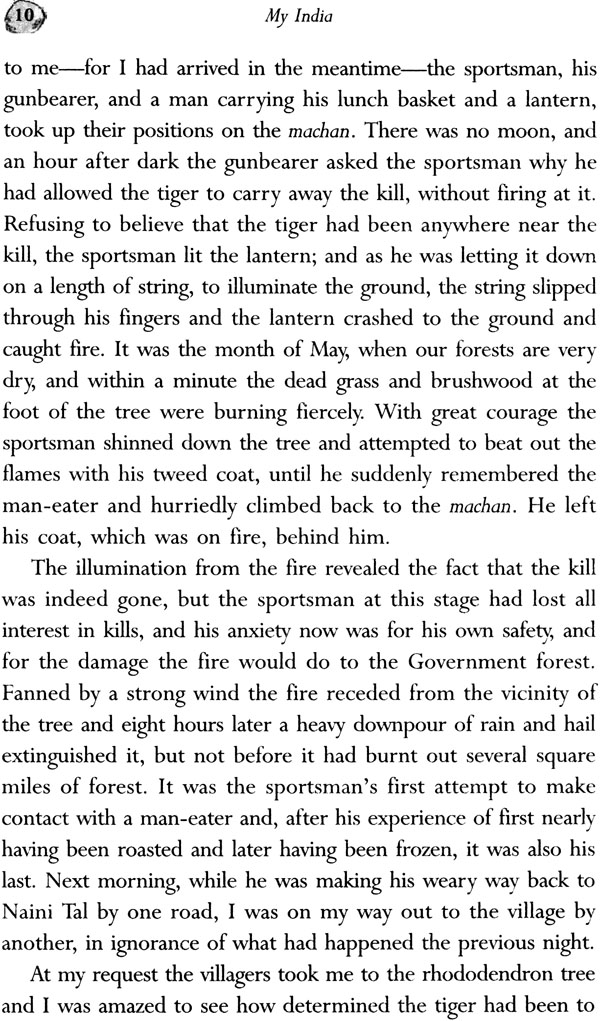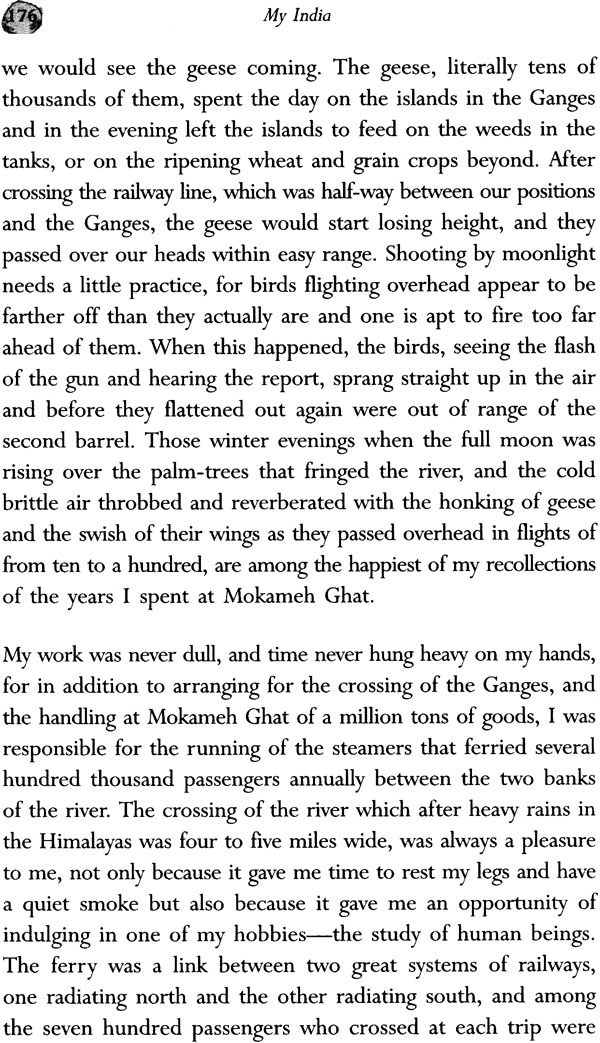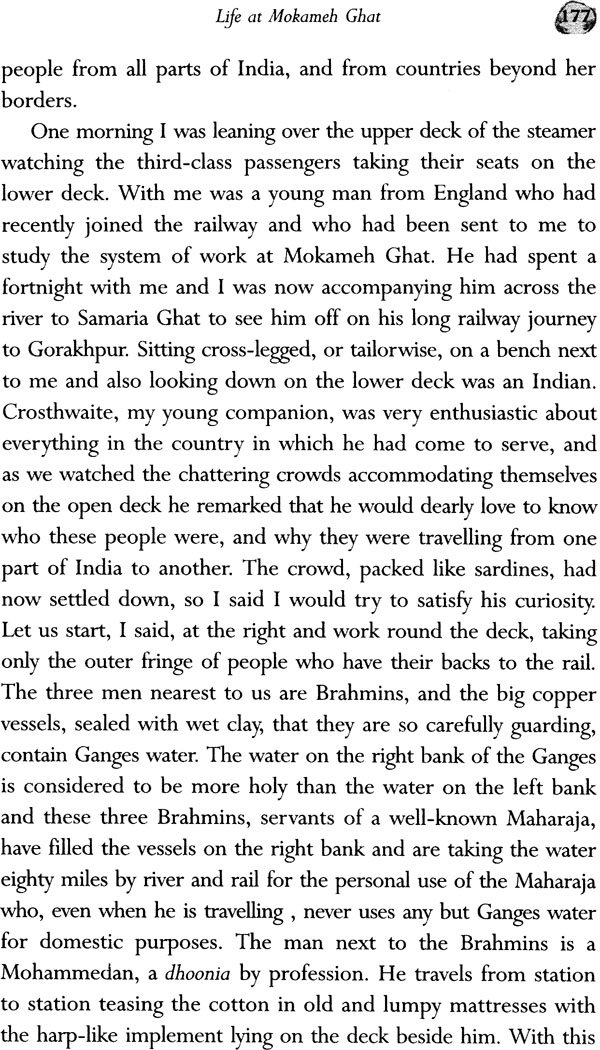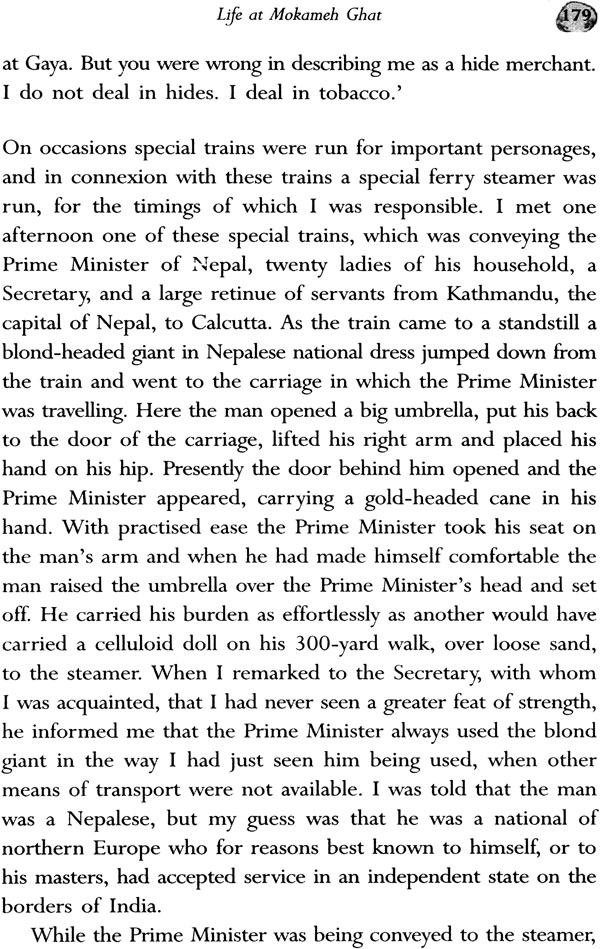
Jim Corbett (My India)
Book Specification
| Item Code: | NAH505 |
| Author: | Amita Malik |
| Publisher: | Oxford University Press, New Delhi |
| Language: | English |
| Edition: | 2020 |
| ISBN: | 9780195623413 |
| Pages: | 196 (Throughout B/W Illustrations) |
| Cover: | Paperback |
| Other Details | 8.5 inch x 5.5 inch |
| Weight | 200 gm |
Book Description
. This book, dedicated to the 'poor of India', sketches with sympathy and concern, village India's life, traditions, and folklore. These stories reflect Corbett's intense love for India, her people, and her flora and fauna. Engaging and deeply evocative, My India is an indispensable supplement for anyone who has enjoyed reading Corbett.
Having read my dedication you may ask: 'Who are these poor of India that you mention?' 'What do you mean by "My India"?' The questions are justified. The world as developed the habit of using the word 'Indian' to denote an inhabitant of the great peninsula that stretches upwards of two thousand miles from north to south, and as much from east to west. Geographically the term may pass muster, but when it comes to applying it to the people themselves one should not, without further explanation, use a description whose looseness has already led to infinite misunderstanding. The four hundred million people of India are divided horizontally by race, tribe, and caste into a far greater diversity than exists in Europe, and they are cleft vertically by religious differences fully as deep as those which sunder anyone nation from another. It was religion, not race, that split the Indian Empire into Hindustan and Pakistan. Let me, therefore, explain what I mean by the title of this book.
'My India', about which these sketches of village life and work are written, refers to those portions of a vast land which I have known from my earliest days, and where I have worked; and the simple folk whose ways and characters I have tried to depict for you are those among whom I spent the greater part of seventy years. Look at a map of India. Pick out Cape Comorin, the most southerly point of the peninsula, and run your eye straight up to where the Gangetic Plain slopes up into the foothills of the Himalayas in the north of the United Provinces. There you will find the hill station of Naini Tal, the summer seat of the Government of the United Provinces, packed from April to November with Europeans and wealthier Indians seeking escape from the heat of the plains, and occupied during the winter only by few permanent residents, of whom most of my life I was one. Now leave this hill station and run your eye down the Ganges river on its way to the sea, past Allahabad, Benares, and Patna, till you reach Mokameh Ghat, where I laboured for twenty-one years. The scenes of my sketches centre round these two points in India: Naini 'Tal and Mokameh Ghat.
In addition to many footpaths, Naini Tal is accessible by a motor road of which we are justly proud, for it has the reputation of being the best-aligned and the best-maintained hill road in India. Starting at the railway terminus of Kathgodam the road, in its course of twenty-two miles, passes through forests where occasionally tiger and the dread hamadryad are to be seen, and climbs 4,500 feet by easy gradients to Naini Tal. Naini Tal can best be described as an open valley running east and west, surrounded on three sides by hills, the highest of which, Cheena, rises to a height of 8,569 feet. It is open at the end from which the motor road approaches it. Nestling in the valley is a lake a little more than two miles in circumference, fed at the upper end by a perennial spring and overflowing at the other end where the motor road terminates. At the upper and lower ends of the valley there are bazaars and the surrounding wooded hills are dotted with residential houses, churches, schools, clubs, and hotels. Near the margin of the lake are boat houses, a picturesque Hindu temple, and a very sacred rock shrine presided over by an old Brahmin priest who has been a lifelong friend of mine.
Geologists differ in their opinion as to the origin of the lake, some attributing it to glaciers and landslides, others to volcanic action. Hindu legends, however, give the credit for the lake to three ancient sages, Atri, Pulastya, and Pulaha. The sacred book Skanda-Puran tells how, while on a penitential pilgrimage, these three sages arrived at the crest of Cheena and, finding no water to quench their thirst, dug a hole at the foot of the hill and syphoned water into it from Manasarowar, the sacred lake in Tibet. After the departure of the sages the goddess Naini arrived and took up her abode in the waters of the lake. In course of time forests grew on the sides of the excavation and, attracted by the water and the vegetation, birds and animals in great numbers made their home in the valley. Within a radius of four miles of the goddess's temple I have, in addition to other animals, seen tiger, leopard, bear, and sambhar, and in the same area identified one hundred and twenty-eight varieties of birds.
Rumours of the existence of the lake reached the early administrators of this part of India, and as the hill people were unwilling to disclose the position of their sacred lake, one of these administrators, in the year 1839, hit on the ingenious plan of placing a large stone on the head of a hill man, telling him he would have to carry it until he arrived at goddess Naini's lake. After wandering over the hills for many days the man eventually got tired of carrying the stone, and led the party who were following him to the lake. The stone alleged to have been carried by the man was shown to me when I was a small boy, and when I remarked that it was a very big stone for a man to carry-it weighed about six hundred pounds-the hill man who showed it to me said, 'Yes, it is a big stone but you must remember that in those days our people were very strong'.
Provide yourself now with a good pair of field glasses and accompany me to the top of Cheena. From here you will get a bird's-eye view of the country surrounding Naini Tal. The road is steep, but if you are interested in birds, trees, and flowers you will not mind the three-mile climb and if you arrive at the top thirsty, as the three sages did, I will show you a crystal-clear spring of cold water to quench your thirst. Having rested and eaten your lunch, turn now to the north. Immediately below you is a deep well-wooded valley running down to the Kosi river. Beyond the river are a number of parallel ridges with villages dotted here and there; on one of these ridges is the town of Almora, and on another, the cantonment of Ranikhet. Beyond these again are more ridges, the highest of which, Dungar Buqual, rises to a height of 14,200 feet and is dwarfed into insignificance by the mighty mass of the snow-clad Himalayas. Sixty miles due north of you, as the crow flies, is Trisul, and to the east and to the west of this imposing 23,406-foot peak the snow mountains stretch in an unbroken line for many hundreds of miles. Where the snows fade out of sight to the west of Trisul are first the Gangotri group, then the glaciers and mountains above the sacred shrines of Kedarnath and Badrinath, and then Kamet made famous by Smythe. To the east of Trisul, and set farther back, you can just see the top of anda Devi (25,689 feet), the highest mountain in India. To your right front is Nanda Kot, the spotless pillow of the goddess Parvati, and a little farther east are the beautiful peaks of Panch Chuli, the 'five cooking-places' used by the Pandavas while on their way to Kailas in Tibet. At the first approach of dawn, while Cheena and the intervening hills are still shrouded in the mantle of night, the snowy range changes from indigo blue to rose pink, and as the sun touches the peaks nearest to heaven the pink. gradually changes to dazzling white. During the day the mountains show up cold and white, each crest trailing a feather of powdered snow, and in the setting sun the scene may be painted pink, gold, or red according to the fancy of heaven's artist.
Turn your back now on the snows and face south. At the limit of your range of vision you will see three cities: Bareilly, Kashipur, and Moradabad. These three cities, the nearest of which, Kashipur, is some fifty miles as the crow flies, are on the main railway that runs between Calcutta and the Punjab. There are three belts of country between the railway and the foothills: first a cultivated belt some twenty miles wide, then a grass belt ten miles wide known as the Terai, and third a tree belt ten miles wide known as the Bhabar. In the Bhabar belt, which extends right up to the foothills, clearings have been made, and on this rich fertile soil, watered by many streams, villages of varying size have been established.
The nearest group of villages, Kaladhungi, is fifteen miles from Naini Tal by road, and at the upper end of this group you will see our village, Choti Haldwani, surrounded by a three-mile-long stone wall. Only the roof of our cottage, which is at the junction of the road running down from Naini Tal with the road skirting the foothills, is visible in a group of big trees. The foothills in this area are composed almost entirely of iron ore, and it was at Kaladhungi that iron was first smelted in northern India. The fuel used was wood, and as the King of Kumaon, General Sir Henry Ramsay, feared that the furnaces would consume all the forests in the Bhabar, he closed down the foundries. Between Kaladhungi and your seat on Cheena the low hills are densely wooded with sal, the trees which supply our railways with ties, or sleepers, and in the nearest fold of the ridge nestles the little lake of Khurpa Tal, surrounded by fields on which the best potatoes in India are grown. Away in the distance, to the right, you can see the sun glinting on the Ganges, and to the left you can see it glinting on the Sarda; the distance between these two rivers where they leave the foothills is roughly two hundred miles.
Now turn to the east, and before you in the near and middle distance you will see the country described in old gazetteers as 'the district of sixty lakes'. Many of these lakes have silted up, some in my lifetime, and the only ones of any size that now remain are Naini Tal, Sat Tal, Bhim Tal, and Nakuchia Tal. Beyond Nakuchia Tal is the cone-shaped hill, Choti Kailas. The gods do not favour the killing of bird or beast on this sacred hill, and the last man who disregarded their wishes-a soldier on leave during the war-unaccountably lost his footing after killing a mountain goat and, in full view of his two companions, fell a thousand feet into the valley below. Beyond Choti Kailas is the Kala Agar ridge on which I hunted the Chowgarh man-eating tiger for two years, and beyond this ridge the mountains of Nepal fade out of sight.
Turn now to the west. But first it will be necessary for you to descend a few hundred feet and take up a new position on Deopatta, a rocky peak 7,991 feet high adjoining Cheena. Immediately below you is a deep, wide, and densely wooded valley which starts on the saddle between Cheena and Deopatta and extends through Dachouri to Kaladhungi. It is richer in floraand fauna than any other in the Himalayas, and beyond this beautiful valley the hills extend in an unbroken line up to the Ganges, the waters of which you can see glinting in the sun over a hundred miles away. On the far side of the Ganges are the Siwalik range of hills-hills that were old before the mighty Himalayas were born.
| Introduction | 1 | |
| I | The Queen of the Village | 7 |
| II | Kunwar Singh | 16 |
| III | Mothi | 29 |
| IV | Pre-Red Tape Days | 56 |
| V | The Law of the Jungles | 64 |
| VI | The Brothers | 78 |
| VII | Sultana: India's Robin Hood | 90 |
| VIII | Loyalty | 131 |
| IX | Budhu | 151 |
| X | Lalajee | 157 |
| XI | Chamari | 164 |
| XII | Life at Mokameh Ghat | 173 |













